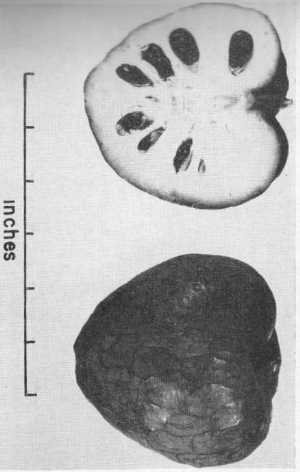Sunset®: 21-25
USDA: 10
Frost Tolerance: Semi tender in Phoenix to 25°F (-4°C)
Heat Tolerance: Questionnable
Sun Exposure: Full sun to light shade
Origin: Mountain valleys of Peru and Ecuador
Growth Habits: Small briefly deciduous tree, up to 25 feet tall (7.5 m)
Watering Needs: Regular water
Propagation: Graft
The genus Annona comprises more than 50 species of trees and shrubs; with few exceptions, they are native to tropical America. A number of species produce edible fruits, which are composed of numerous carpels more or less fused to the fleshy receptacle. The annonas exhibit great variation in climatic and soil requirements as well as in quality of fruit, which suggests that improved types could be developed readily by controlled crosses and by selection.
The Atemoya, a cross between the cherimoya and the sugar apple, has proved satisfactory for southern Florida.
The Cherimoya, native to the mountain valleys of Peru and Ecuador, was early introduced into Mexico and Central America. It is a small, somewhat spreading tree, rarely more than 25 feet in height, and normally begins to produce fruit when 4 to 5 years of age. The leaves vary in size; in some varieties they reach a length of 10 inches. The upper surface of the leaves is sparsely hairy and the lower surface is velvety-tomentose.
The cherimoya is essentially a subtropical fruit and has not grown well in the coastal area near Mayaguez (Puerto-Rico), where the trees bear only a few fruits of very poor quality. It can, however, be grown under the conditions of lower temperatures that prevail in the mountainous regions.
The Ilama (Annona diversifolia Saff.) produces fruit similar to that of the cherimoya. The foliage is similar to that of the sweetsop but can be distinguished from the latter by the leaflike bracts at the bases of the smaller branchlets. The conical or ovid fruits vary from types having a smooth surface to those having carpels with short, thick protuberances. The skin color varies from light green to pinkish. The white or pinkish flesh has a subacid to sweet flavor. Although resembling the cherimoya in fruit shape and taste, the ilama grows well in the lowlands of the Tropics. It is commonly propagated by seeds but has been successfully veneer grafted.
Blooming Habits:
The inch-long, perfect flowers are produced in the axils of the leaves.
Fruiting Habits:
The fruits vary in form but usually are heart-shaped or conical. The light-green surface of the fruit is variable in appearance. In some varieties it is almost smooth with slight depressions (termed "fingerprinted"), but in others the carpels are terminated by an abrupt point. The flesh is creamy white and has many dark-brown seeds imbedded in it, It has a custardlike consistency and a subacid flavor suggestive of a blend of banana and pineapple.
From the standpoint of quality, it is the best fruit of the genus and is one of the finest tropical fruits. By some it is considered to be equal to, or even superior to, the mangosteen. Cherimoya fruits reach a large size, often weighing 4 to 6 pounds.
Culture:
It has been reported from California that the male and female of the flower frequently do not mature at the same time. Therefore, cross-pollination of the flowers on the same tree or of different trees is necessary. This can be accomplished readily by transferring mature Dollen to the receptive stigma of a freshly opened flower with a camel's-hair brush. Studies in Peru have indicated that hand-pollinated fruits are larger and less irregular in shape than those pollinated by natural means.
Propagation:
Many varieties of cherimoya have been named, including Bays, Chaffey (fig. 5), McPherson, and Whaley. They are propagated by budding or grafting on vigorous seedlings of the same species. Seedlings of the custard apple and of the sweetsop also can be used as rootstocks.
Desert-Tropicals is dedicated to provide gardening advice, gardening ideas, and information about flower of all kind for landscape and collections.We try to check carefully the identification of the plants on the illustrations as well as the other information from the page, but occasionally errors do occur. if you notice anything that needs to be changed please contact us.Thanks.
© 1998-2020 Philippe Faucon, All Rights Reserved.
